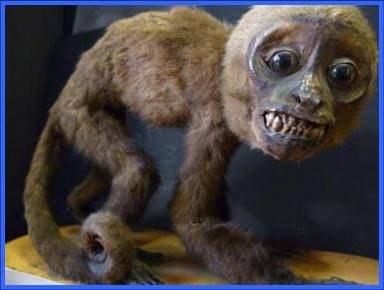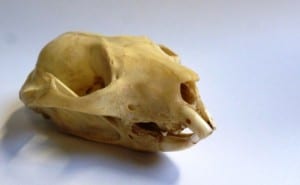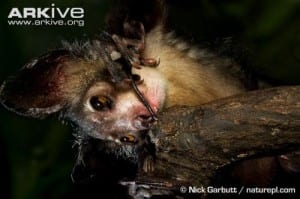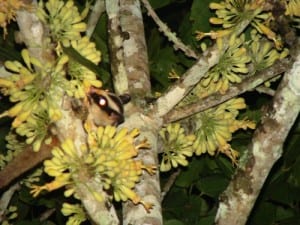Specimen of the Week: Week 141
By Jack Ashby, on 23 June 2014
 Zoology is tribal. To the outside world natural historians present a united front: the geologist is my brother and the botanist my friend. But hidden within are genial rivalries. You might find that those noble folk studying the less sexy animal groups carry a certain disdain for the Hollywood animal fanciers. In palaeontology, fossil coral experts cry themselves to sleep at night when yet another dinosaur story makes the newspapers. In zoology, there is nothing more mainstream than primatology. As a mammal nerd I would certainly be considered on the mass-appeal end of the spectrum, but here I present an unfamous species lost in the shadow cast by a much-celebrated primate in a similar ecological niche. This weeks specimen of the week is…
Zoology is tribal. To the outside world natural historians present a united front: the geologist is my brother and the botanist my friend. But hidden within are genial rivalries. You might find that those noble folk studying the less sexy animal groups carry a certain disdain for the Hollywood animal fanciers. In palaeontology, fossil coral experts cry themselves to sleep at night when yet another dinosaur story makes the newspapers. In zoology, there is nothing more mainstream than primatology. As a mammal nerd I would certainly be considered on the mass-appeal end of the spectrum, but here I present an unfamous species lost in the shadow cast by a much-celebrated primate in a similar ecological niche. This weeks specimen of the week is…
**The striped possum skull**
1) Striped possums are basically the marsupial version of aye-ayes. Marsupials are probably the most down-trodden of the mammalian kind. There are convincing suggestions that the inaccurate denigration of marsupials as inferior, “less advanced” mammals is/was a hemispherist political colonial mindset born of the implication that Australia and the southern continents are less advanced, both faunally and socio-politically, than the north. Add in the fact that aye-ayes are primates (like humans) and we might understand why all the glory is given to aye-ayes instead of striped possums. Ok. Enough tub-thumping.
2) Striped possums share with aye-ayes a long, spindly finger (their genus Dactylopsila means “naked finger”), and protruding, gouging incisors. Like aye-ayes, they use their teeth to lever open a hole in bark and wood, and then use the long finger to hook out their beetle larva prey. They live and feed in trees. Among all mammals the ability to grip a branch with opposable digits has only evolved twice – in marsupials and primates. That’s another thing striped possums share with aye-ayes.
3) This skull belongs to Dactylopsila trivirgata and was collected in New Guinea – the home of four species in the striped possum family. Interestingly, this species (but not the other three) also extends down into the rainforests of far northeastern Queensland, which could suggest that the population there is a recent colonisation from New Guinea, but a long-term fossil record of striped possums in Australia dates back around 25 million years (Van Dyck and Strahan, 2008).
4) Despite rarely being discovered foraging together, they do come to each other’s aid. Amethystine pythons – the largest Australian snake – learn the locations of their tree den hollows and wait there to attack returning possums. When attacked the possums let out an extremely loud cry (for a 450 gram animal) and others come running to mob the snake. Older possums will use multiple den sites to decrease this kind of predation.
5) Striped possums have the largest brain to body size ratio of any marsupial. Marsupials have often been dismissed as inferior as people thought they had smaller brains than similarly-sized placental mammals (another anti-marsupial injustice). But recent research here at UCL has shown that this isn’t true. It’s a misconception driven by the inclusion in comparative studies of one large-brained placental group, the primates (Weisbecker and Goswami, 2010)
6) Bonus self-indulgent story: I camped in a spot known to be frequented by striped possums, adding an extra night onto my trip as each day passed without seeing one. Each night (for they are nocturnal) I got up a few times to search for them with my spot-light. After an unsuccessful week I had one final night before I had to leave (in true natural history documentary style), so decided to set an alarm for every two hours throughout the night to give myself more chances. At 5am, just as the dawn was breaking – the very last chance I would have – I found one. He scampered after 30 seconds. It was so very worth it.
References
Van Dyck, Steve & Strahan, Ronald 2008, The mammals of Australia, 3rd ed, New Holland Publishers, Sydney
Weisbecker, Vera and Goswami, Anjali 2010 Brain size, life history, and metabolism at the marsupial/placental dichotomy PNAS 2010 107 (37) 16216-16221
Jack Ashby is the Manager of the Grant Museum of Zoology.
 Close
Close




